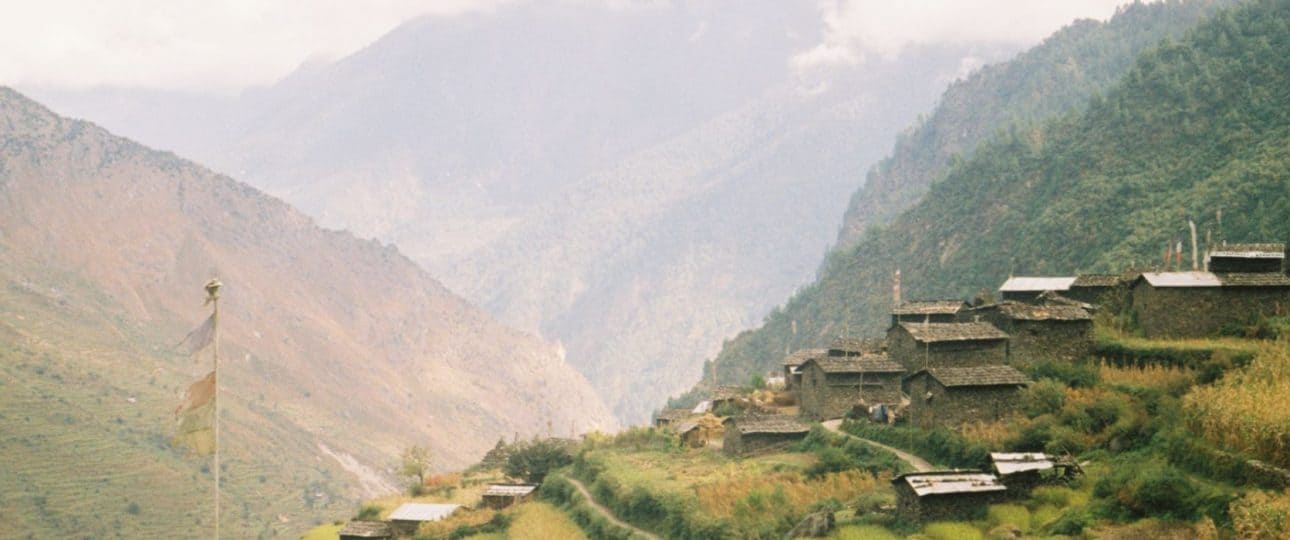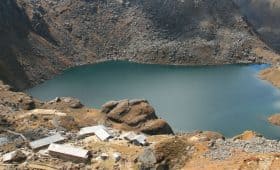Langtang Valley is a famous trekking destination in Nepal, combining picturesque landscapes, snow-capped mountains, and the unique culture of the locals. As an ideal destination for trekkers around the world, Langtang Valley attracts thousands of tourists each year.
Table of Contents
- Langtang Village Before Earthquake:
- Langtang Village on the day of earthquake-triggered avalanche:
- Langtang Village After Earthquake
- Langtang Village After Earthquake
- Go for This Unique Adventure in Langtang Valley
- What can we do to help the locals of Langtang Valley?
- FAQs
- What made Langtang Village unique before the earthquake?
- How did the earthquake impact Langtang’s cultural heritage?
- What were the immediate challenges faced in the rescue and recovery process?
- How is Langtang Village recovering today?
- What lessons can be learned from Langtang’s experience for earthquake-prone regions?
Langtang Village Before Earthquake:
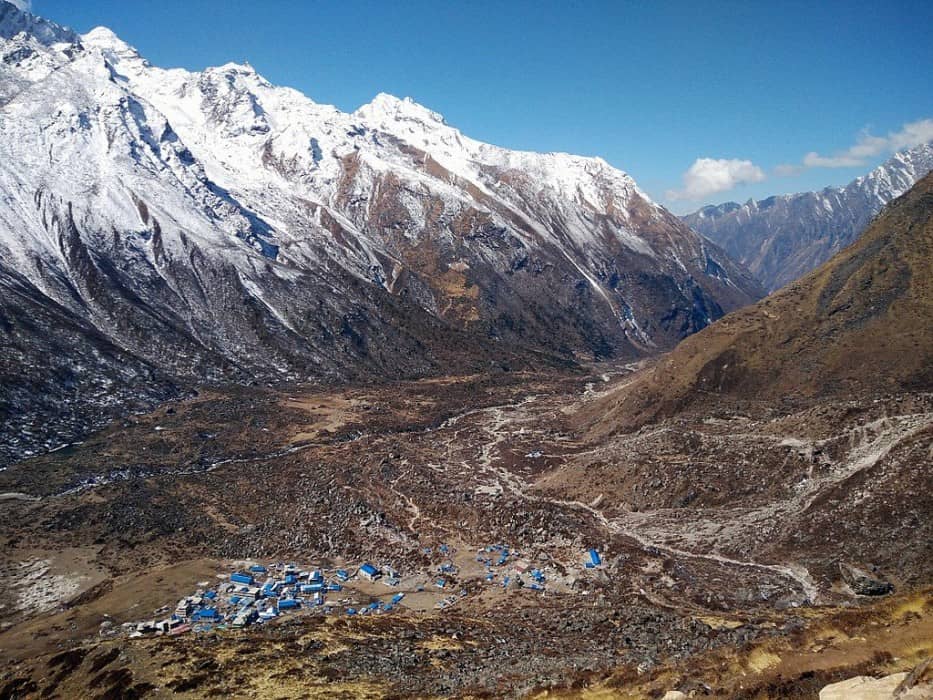
Life in Langtang Village was good. The local people, mainly comprising Tamang, Sherpa, and Gurung, would wake up early, finish their household chores, take their yaks and mules to graze, and head to the field. Many villagers operated lodges for trekkers, as trekkers from around the world come to the region. Some villagers worked as Langtang Valley trek guides and porters, earning good incomes.
Langtang was gradually attracting more and more travelers, both foreign and domestic, turning homestays into lodges, increasing locals’ earnings, and introducing more facilities. The locals found Langtang Lirung more attractive as it kept attracting trekkers. Yak and mule herds in the valley beautified the place, while Gompas attracted tourists and Buddhist devotees alike. Among the Buddhist shrines, Kyanjin Gompa was becoming more popular. It seemed like all was going well.
That was until the 25th of April 2015. Who knew their world would come tumbling down in a matter of seconds.
The beautiful Langtang Valley carries a lot of pain within her. When the devastating quake hit Nepal in April of 2015, the entire country shook with fear. Thousands of aftershocks followed the quake for months. People lost their lives, homes came tumbling down, and basic supplies were lacking everywhere. Langtang Valley was one of the worst-hit areas.
A teenager from Langtang Village who survived the disaster relived the moment, “It was not the quake that accounted for the complete damage, the avalanche that followed was what buried the entire village under rubble.” The beautiful Langtang Valley was utterly destroyed. Within a minute, the village entirely vanished under a mudslide of sand, snow, boulders, and huge rocks. Almost everyone died.
Want more information? Send us your query, and our experts will get back to you within 24 hrs.
Langtang Village on the day of earthquake-triggered avalanche:
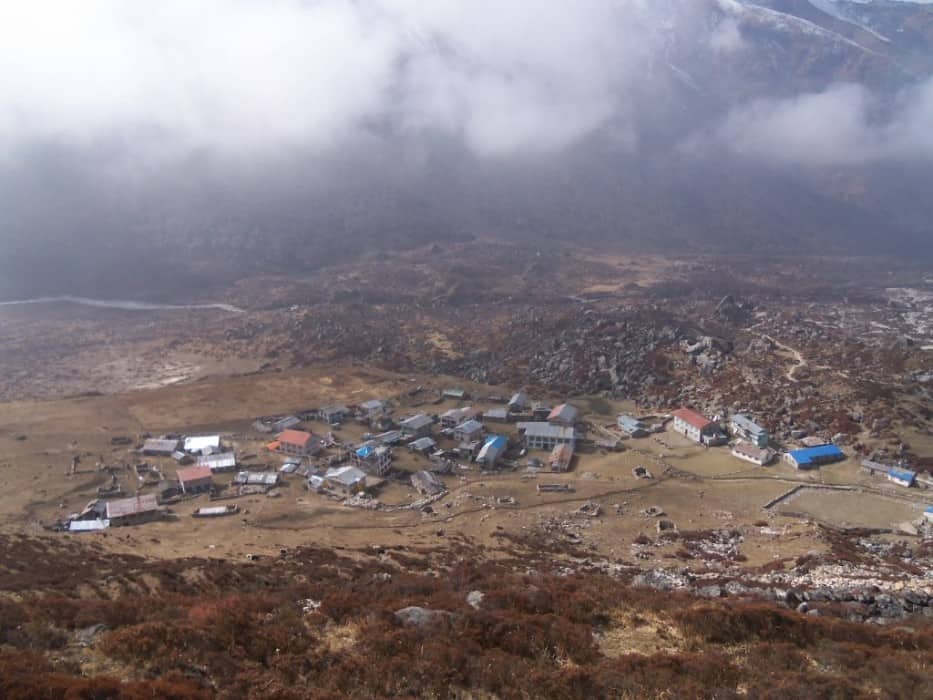
It was April 25, 2015. The day before, people had celebrated Ghawa – a yearly Buddhist ceremony. All the villagers had gathered to sing and dance, including people from neighboring villages. They drank, sang, and danced.
As the celebration had lasted until midnight, the next day was a bit different from normal. People stayed in bed longer than usual. But the day looked just like another normal day of Spring as the sun rose higher. The villagers were busy with their work.
Some trekkers had already continued their trek towards their destination, while some were resting and enjoying the heavenly environment. Some of them were getting ready to head towards their destination.
The clock struck 11:55, and the unexpected happened. The violent shaking of the land made everyone panic and run for their lives. People who were in their house fled outside running. Those who were on the field saw something disastrous was coming towards them. The violent quake resulted in a massive avalanche. It looked like the entire mountain came crumbling down.
The village, which was a popular stop for thousands of travelers over the years, was home to more than 400 people and buried in ruins. Most of the villagers and travelers lost their lives. Within a minute, Langtang Village turned into tattered remains.
A single house stood partly, and only a very few were lucky to survive the incident. Those who survived were mourning their missing loved ones. Some were frantically searching for their loved ones, most of whose efforts were in vain.
The aftershocks continued for days, with small pieces of loose rocks and snow continuing to fall as a result of the aftershocks. Fear remained among the survivors, but gradually, rescue work began to gain momentum. Survivors and rescuers started rescuing victims from the site, recovering many bodies from the mudslide.
Rescuers evacuated villagers by local helicopters to safer villages, and injured people were taken to hospitals, while the search for survivors and bodies continued for days.
After a few days, authorities called off search and rescue attempts due to the constant risk of aftershocks, landslides, and avalanches.
Langtang Village After Earthquake
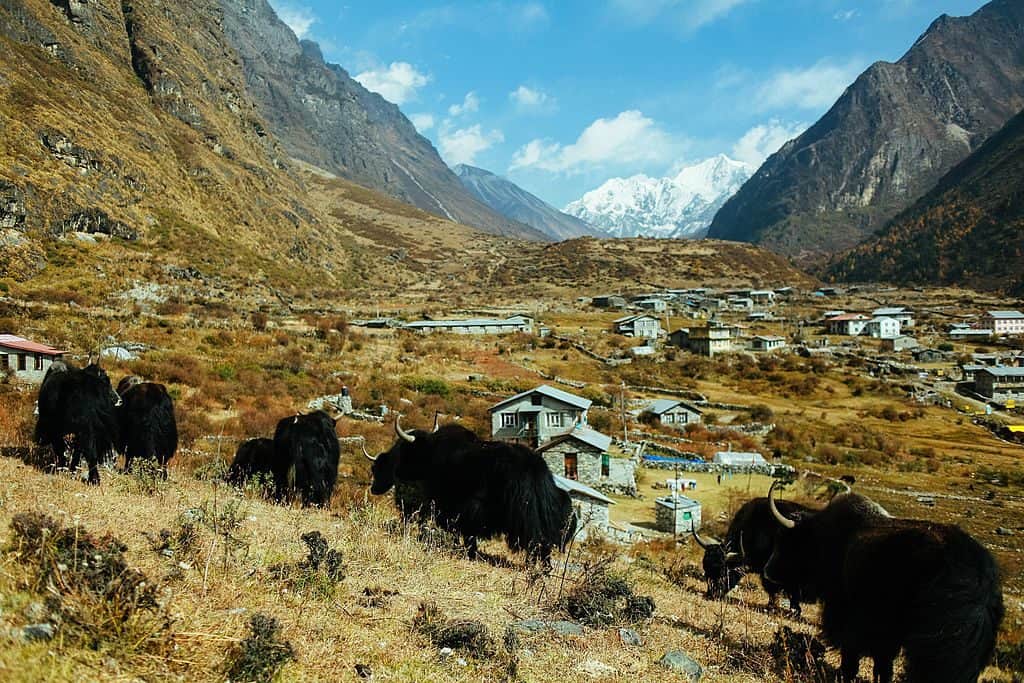
Langtang Village After Earthquake
It has already been more than 7 years since the tragedy (7 years as of editing this post in early 2023), and several foreign researchers have studied the region, marking the Langtang Region safe. Trekkers have begun trekking to Langtang Valley again.
Villagers have built a new village near the buried one, and as the village gradually began picking up the pieces, life is returning to normal. Barren fields are turning into green pastures again, and yaks can be seen grazing there. Tea houses have been rebuilt, and the village has somehow been reconstructed.
As tourism took some time to return to normal in the Langtang Region, locals found it hard to survive there. Now, more than three years later, trekkers have started to flow into Langtang, and teahouses are again filled with travelers during peak seasons. Locals have started to earn again to meet their needs.
Although the pain will remain for their lives, locals have slowly begun to smile again. The Sherpas, Tamangs, and other communities living there are gradually reconstructing the villages again.
That said, the locals are still facing difficulty leading their lives. Parts of their cultivable land are now covered in stones and boulders, and they have spent a lot of money rebuilding their homes and other structures. They have lost their loved ones, and most of them have had to start their lives from scratch.
Today, Langtang is a symbol of strength and determination. People are always doing reconstruction efforts, though the scars of the earthquake remain. But the residence aims to raise the village from the ruins.
Whoever goes there is always inspired to see how the community of Langtang has come together. They never give up and start to to rebuild their village after the devastating earthquake.
The efforts to rebuild the teahouses that once welcomed trekkers is a clear indication of the region’s importance in the trekking industry and a sign of hope for the future.
The Impact of Earthquake
The results of an earthquake are always devastating. It’s not just about the physical damage to the buildings and infrastructure but also the emotional impact it has on the people affected.
Here are some basic impacts that usually change the life routine and cause people to struggle to face real threats. It’s hard to imagine the devastation caused by the earthquake that hit Langtang Valley.
- The earthquake ruins strongly built-houses into unrecognizable streets.
- The people’s emotions are real, with memories mixed with sorrow and resilience.
- After the devastations, survivors must guide the altered landscape, testing their strength and determination.
- The disaster also tore families apart, bringing a human dimension to the tragedy.
- The earthquake threatened the rich culture of Langtang.
Recovery Efforts
After Earthquake the Recovery is about more than just rebuilding structures. It includes healing communities, restoring livelihoods, and ensuring a brighter future for Langtang Village.
There are the following points that can play an important role in the recovery of the whole village. These can prove as some best ways to support the locals of Langtang Valley after the earthquake.
- The first and most urgent task is reconstruction of homes.
- Damaged roads, paths, and every single part must be repaired to reconnect the village and bring in essential supplies.
- When permanent homes are being rebuilt, there’s a need for temporary shelters.
- Medical aid is an urgent need that helps heal physical wounds.
- Restoring water and electricity is a top priority for normality.
- Reforming local businesses is crucial for economic recovery and helps people get back on their feet.
- Rebuild damaged schools and support educational programs to ensure a brighter future for children.
- Community involvement is important for successful recovery. So, engage locals in decision-making processes to align rebuilding efforts with community needs.
- Earthquakes also cause environmental problems. In order to achieve sustainability, the repairs should be focused on basic issues.
- Langtang’s charm attracts many trekkers and tourists. It’s crucial to rebuild trekking routes, promote responsible tourism, and support local livelihoods tied to tourism for the community’s economic recovery.
Go for This Unique Adventure in Langtang Valley
Join Mosaic Adventure on an extraordinary 8-day trekking expedition, carefully designed to immerse you in the stunning landscapes of Langtang Valley.
Engage with the remarkable resilience of the local community and actively contribute to the ongoing rebuilding efforts in Langtang Village.
Distinctive Highlights
- Discover the incredible and less-traveled Langtang Valley with majestic Himalayan peaks, dense
- forests, different villages and rich cultural experiences.
- Experience the genuine hospitality of the locals, fostering connections with the Tamang, Sherpa and Gurung communities.
- Witness the determination of villagers as you visit reconstructed tea houses and lodges, a testament to their unwavering spirit.
- Trek through the amazing Langtang National Park, a haven boasting diverse flora and fauna.
Itinerary
Day 1: Kathmandu to Sybru Bensi (1462 meters)
Begin your journey as we pick you up from your Kathmandu hotel and embark on a scenic 7-hour bus ride to Sybru Bensi.
Day 2: Lama Hotel (2500 meters)
Trek for 5 hours to reach the tranquil Lama Hotel nestled at 2500 meters.
Day 3: Langtang Village (3307 meters)
Continue your trek for 5 hours, reaching the vibrant Langtang Village situated at 3307 meters.
Day 4: Kyanjin Gompa (3798 meters)
Trek for 4 hours to reach the cultural hub of Kyanjin Gompa, standing proudly at 3798 meters.
Day 5: Kyanjin Ri or Tsergo Ri (4773m/4984 meters)
Choose between trekking to Kyanjin Ri (4773m/3 hours) or Tsergo Ri (4984 meters/7 hours) with a return to Kyanjin Gompa.
Day 6: Return to Lama Hotel
Trek for 6 hours, retracing your steps back to the serene Lama Hotel.
Day 7: Return to Sybru Besi
Continue your journey with a 6-hour trek to reach Sybru Besi.
Day 8: Sybru Besi to Kathmandu
Finish your adventure with a 7-hour bus ride back to Kathmandu, followed by a transfer to your hotel.
Visit the trip page for detailed information.
Availability
Our Langtang Valley trek package is open year-round, with the optimal seasons being spring and autumn. Customizable options are available to suit your preferences. Check our website or contact us for specific dates and availability.
Current Offer
Currently, we are offering this 8-day trek for just USD 515/person.
Inclusions
- Experienced trekking guides familiar with the Langtang region.
- Porter (one between 2 participants).
- Accommodations in tea houses and lodges.
- All necessary permits and entrance fees.
- Transportation to and from Kathmandu (Local buses).
- Meals during the trek.
- All applicable taxes.
Contact Us
For more details on our 8-day Langtang Valley trek package, booking information, or any inquiries, feel free to reach out to us. Our team of experts is dedicated to assisting you in planning a trekking experience that is both memorable and impactful.
What can we do to help the locals of Langtang Valley?
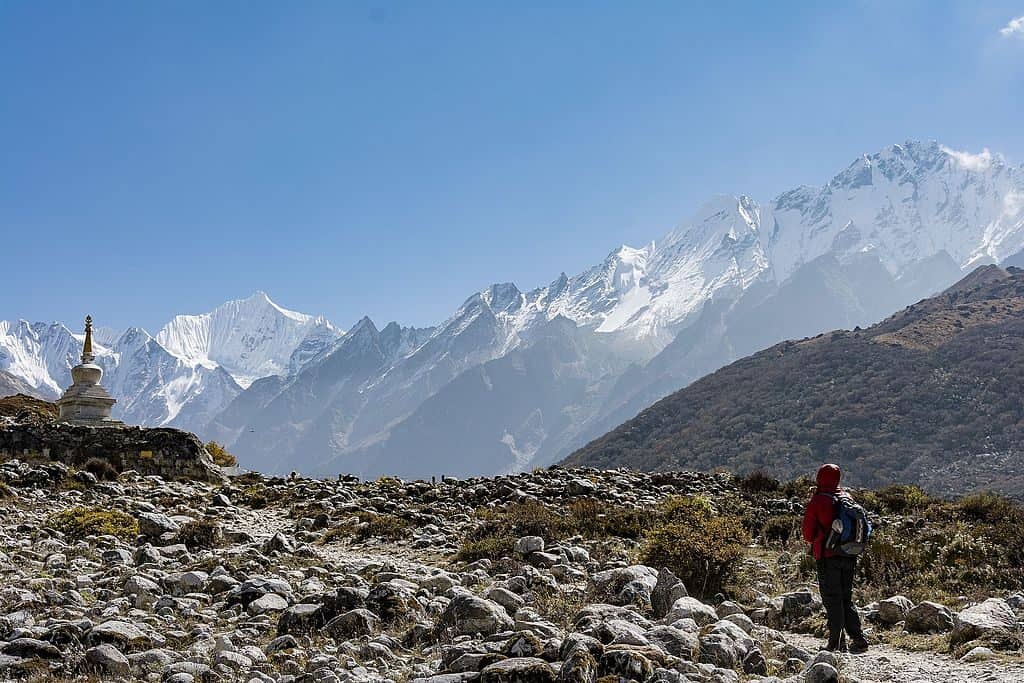
Nepal received a lot of support after the earthquake, but aid poorly reached the victims. If you send money or materials to the people of Langtang Valley, you never know if your support will reach the needy ones or not.
Instead, it’s better to trek to Langtang Village with your friends or family during your vacation. This will help them to live on their own and improve their economic condition.
The hopeful locals have cleared the trails and rebuilt lodges, and are waiting for trekkers. Now, they have two sides to show you – the ravishing Langtang world and the pain that it carries. Why not pay them a visit?
If you are interested in the trek, you can visit Langtang Village with us or contact us for more information about the trek to Langtang Valley.
Want more information? Send us your query, and our experts will get back to you within 24 hrs.
FAQs
What made Langtang Village unique before the earthquake?
Langtang Village was well known for its traditional Nepalese architecture, tight-knit community, and vibrant cultural practices. It served as a crucial stop for trekkers exploring the Himalayan region, offering a glimpse into the rich hospitality of the local people.
How did the earthquake impact Langtang’s cultural heritage?
The earthquake caused great cultural damage to Langtang’s heritage. Traditional houses were crushed, and the village’s unique cultural practices faced the threat of being lost. The emotional toll on residents and trekkers further added to the impact.
What were the immediate challenges faced in the rescue and recovery process?
The rescue and recovery efforts in Langtang faced numerous challenges, including impassable roads, disrupted communication, and the harsh Himalayan terrain. These obstacles tested the resilience of both local and international aid organizations involved in the response.
How is Langtang Village recovering today?
Today, Langtang is in the process of recovery. Reconstruction efforts are ongoing, with a focus on rebuilding homes, restoring cultural practices, and reviving the village’s importance in the trekking industry. The slow but steady transformation of the landscape will be a beautiful sight to behold.
What lessons can be learned from Langtang’s experience for earthquake-prone regions?
Langtang’s experience underscores the importance of earthquake preparedness in regions prone to seismic activity. The blog post emphasizes the need for swift and coordinated responses to mitigate the impact on communities. The global support for Langtang highlights the interconnectedness of our world in times of crisis.
Conclusion
The journey of Langtang Village is no less than an inspiration. It is a story of resilience, unity, and hope that depicts the spirit of Nepal and its people. Despite the scars left by the earthquake, Langtang has emerged as a symbol of strength to the power of the community. The village has opened its doors to trekkers and well-wishers, inviting them to witness its transformation.
Want more information? Contact us or send us your query, and our experts will get back to you within 24 hours.

Madhav started working as a porter in 2001 and then moved on to work as a trekking guide. After working in the trekking and tourism industry for eight years, he co-founded Mosaic Adventure in 2009.
Madhav has trekked to most of the trekking destinations in Nepal, including Everest Base Camp Trek, Annapurna Base Camp, Annapurna Circuit Trek, Poon Hill Trek, Jomsom Muktinath Trek, Indigenous Peoples Trek, Langtang Valley Trek, Mardi Himal Trek, and all of the day hikes around Kathmandu.
He has also extensively traveled to other countries such as Australia, the USA, the UK, France, Hong Kong, Japan, China, the Philippines, the UAE, Saudi Arabia, Bahrain, Thailand, Turkey, and India. Madhav is the one who answers most of your questions about trekking and tours and helps to plan your trip by giving a personal touch.

